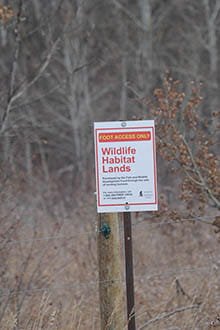Fish and Wildlife Development Fund
The Fish and Wildlife Development Fund (FWDF) was developed to manage, preserve and enhance fish and wildlife habitat in Saskatchewan.
The fund has three fish and wildlife management goals:
- Maintain natural habitat through conservation, biodiversity, land management and awareness of rare species;
- Maintain and grow sustainable fish populations and fish habitat; and
- Maintain game populations and ensure accessible hunting.
Contributing to the FWDF
Thirty per cent of the revenue from all hunting, angling and trapping licence sales is contributed to the fund. Additionally, monetary contributions to the fund can be made through your Hunting, Angling and Trapping Licence (HAL) system account.
You can also help support the sustainable management and use of fish and wildlife resources by:
- Supporting programs that conserve wildlife and fisheries habitat;
- Joining or supporting your local conservation group or wildlife federation;
- Planting shelterbelts (using native fruit-bearing species), protecting wetlands, including their riparian areas;
- Maintaining large or small natural areas; and
- Ensuring your activities on the landscape do not contribute to the introduction or spread of invasive species.
What Does the FWDF Do?
Fisheries Conservation
In 2014, the Saskatchewan Wildlife Federation took responsibility for fisheries enhancement, including operation of the Saskatchewan Fish Hatchery. However, ownership of the hatchery and broodstock, along with FWDF program oversight, policy development and decisions related to fish stocking remains the responsibility of the Government of Saskatchewan.
Each winter, FWDF aeration projects help maintain the dissolved oxygen levels necessary to keep fish populations alive. These systems result in areas of open water or thin, unsafe ice conditions. Warning signs will be posted on waters with aeration systems and we ask that you please exercise caution and observe all warnings.
Land Conservation
The number of FWDF activities has increased in recent years to combine the ways habitat is conserved for the benefit of all aquatic and terrestrial wildlife species (harvested and non-hunted), including:
- Forming partnerships with non-government organizations;
- Protecting habitat through purchase and conservation easements; and
- Use of interest generated on revenues to pay rural municipalities (>100) grants-in-lieu of taxes on FWDF lands.
Habitat Management
We manage FWDF lands to provide the best possible wildlife habitat year-round for the greatest number of species. Many cultivated hectares have been converted to forage, with local farmers haying the lands and using grazing as part of a vegetation management plan. We carry out weed and pest control on FDWF lands to ensure we're a good neighbour.
We also encourage and fund co-operative projects with local, volunteer interest groups that may involve planting trees, as well as clearing away old buildings, machinery and fences.
For more information on haying or grazing opportunities can be found on the FWDF website.
You Can Use Wildlife Lands
Wildlife lands are not reserves or sanctuaries. These natural areas have been bought with your hunting and trapping dollars, and can be used by everyone. You can view the various FWDF lands through Saskatchewan Interactive Maps.
FWDF lands are marked with signage.

Hunting and trapping is allowed on these lands. Lands are also open to other outdoor nature enthusiasts, including hikers, bird watchers and photographers. When visiting FWDF lands, please respect the following rules:
- Walk-in traffic only (except when retrieving legally-taken big game during hunting season);
- Walk-in camping only – no open fires;
- No littering; and
- No interference with an authorized management treatment (e.g., haying or grazing).

